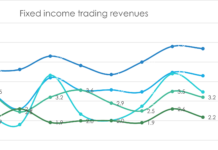The impact of this week’s market volatility has varied drastically from one trading desk to another, according to the portfolios being traded for, but at best was “not easy conditions”.
“For cable (USD/GBP currency pair), it was a crazy week,” says Stephane Malrait, global head of market structure and innovation for financial markets at ING Bank.
Bryn Jones, head of fixed income for Rathbones, says, “It has been a very volatile and the gilt market has been under attack, post the announcement by the UK government that it needed to borrow a lot more money while at the same time, the government were doing quantitative tightening, bringing into question the feasibility of the UK’s ability to finance itself. Looking at yields on the government bond market yesterday morning, before the announcements of bond buying, the 30-year gilt was trading wider than Greek government debt.”
The intervention of the Bank of England provided some relief to the market, but the reflexive nature of the intervention contributed to volatility.
“Long index-linked Gilts bought in November would have cost you 400 pence,” he continues. “Last week they were trading at 117, yesterday morning at 50 pence in the pound. So it’s halved in the space of a few days. When the Bank of England announced it would buy a limited amount of long bond in the short term, it sent the long bonds rallying 70 basis points. We’ve had some volatility like I’ve never seen in my entire career, working in Sterling markets. Credit spreads continue to widen and liquidity is quite poor.”
A big part of the activity was driven by the use of government bonds as collateral, being posted with counterparties as insurance against a default. Margin requirements for covering derivative exposure – often used as a hedge against risk – typically require either cash or government bonds to be used.
Lee Bartholomew, global head of derivatives product R&D for fixed income & FX at Eurex says, “In 2008 the large intraday volatility was driven by credit, we are now in a different paradigm; there’s an argument that a scarcity of collateral is one of the underlying issues that we see in financial markets, not credit and that has exacerbated some of the liquidity issues we are seeing.”
Joe Midmore, CCO of fintech OpenGamma, says, “UK pension funds are having to post significant variation margin, in cash, due to the plummeting pound and rising Gilt yields. Compound this with increasing initial margin requirements that reflect heightened market volatility, and you end up with a perfect funding storm that equates to an enormous cost that is ultimately borne by end investors. As investors continue to scrutinise every penny, long dated and directional strategies are increasingly needing to seek out pre- and post-trade optimisation recommendations to help minimise funding costs in a bid to protect returns.”
Despite the risks and volatility, there are positive signs which this market has revealed.
“This week was a big event but from an operational point of view the industry is now much more mature compared to previous years,” says Malrait. “Compared to what happened a few years ago when we had similar events in Cable in the Asia timezone, at that point there were a lot of breaks in the system with algos, trading, and reporting; I didn’t see anything like that this week.”
Jones also spies opportunity for bold investors, thanks to the yields on offer.
“Right now yields are looking relatively attractive,” he says. “Five percent for a 30 year gilt – you have to go back to 1998 for that. I don’t think I don’t think inflation is going to remain as sticky as everyone thinks. Global money supply has fallen by about 80%. That’s a lot. Economists are still talking about inflation next year at around 3-4%. Arguably it could drop a lot below that. So, what’s the best way to hedge your portfolio? Well, it’s to buy duration and the highest quality assets, which is investment grade. Senior bank paper, is at 7-8%, subordinated insurance is double digit, these could potentially be a once-in-a-decade opportunities to add to the fixed income market.”
©Markets Media Europe 2025













